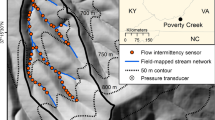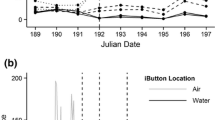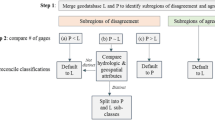Abstract
Wetland scientists and managers recognize the need to characterize hydrology for understanding wetland ecosystems. Hydrologic data, however, are not routinely collected in wetlands, in part because of a lack of knowledge about how to effectively measure hydrologic attributes and how frequently to measure water levels. To determine how measurement interval affects interpretation of water-level data, we analyzed data from seven wetlands in Oregon and Pennsylvania. We created subsets of daily data for each wetland, with measurement intervals of 2 to 28 days, then compared those subsets to the daily data for annual water-level summary statistics, monthly mean water levels, and occurrence/duration of threshold conditions (e.g., water in the root zone). Our primary goal was to determine if sampling at low frequencies can provide representative water-level data and accurate perceptions of the occurrence of water levels above thresholds. For annual water-level distributions, small data sets from 28-day measurement intervals provided summary data (e.g., median, quartiles, range) comparable to the 1-day reference data. For measurement intervals of seven days or less, average errors in estimates of stage (minimum, 25th, 50th, and 75th percentiles) were ≤0.03 m; for a 28-day interval, average errors were <0.05 m. Errors in estimates of maximum stage were considerably larger (0.11 m and 0.21 m for 7-and 28-day intervals, respectively) but can be circumvented using crest gauges. Errors in estimates of monthly mean stage varied greatly with measurement frequency (1–4% error for 7-day intervals, 5–15% error using one measurement per month), among wetlands and from month to month. Water-level durations above threshold values were problematic; for measurement intervals of 2 days and longer, 14-day exceedances of water in the root zone were frequently missed or spurious exceedance periods were identified. Overall, results show that sampling at monthly intervals, supplemented with crest gauges, provides a representative description of annual water-level distributions for use in classifying and comparing wetlands. More frequent sampling is required to characterize water levels for shorter (e.g., monthly) time periods and to reliably identify exceedance periods for water above threshold levels. More generally, the results remind us that the frequency and duration of sampling in hydrologic studies must be designed to ensure that data will support planned analyses.
Similar content being viewed by others
Literature Cited
Carter, V., J. S. Bedinger, R. P. Novitzki, and W. O. Wilen. 1979. Water resources and wetlands. p. 344–376. In P. E. Greeson, J. R. Clark, and J. E. Clark (eds.) Wetland Functions and Values: The State of Our Understanding. American Water Resources Assoc., Minneapolis, MN, USA.
Cole, C. A. and R. P. Brooks. 2000. A comparison of the hydrologic characteristics of natural and created mainstem floodplain wetlands in Pennsylvania., Ecological Engineering 14:221–231.
Cole, C. A., R. P. Brooks, and D. H. Wardrop. 1997. Wetland hydrology as a function of hydrogeomorphic (HGM) subclass. Wetlands 17:456–467.
Cowardin, L. M., V. Carter, F. C. Golet, and E. T. LaRoe. 1979. Classification of Wetlands and Deepwater Habitats of the United States. U.S. Department of the Interior, Fish and Wildlife Service, Washington, DC, USA. FWS/OBS-79/31.
Environmental Laboratory. 1987. Corps of Engineers Wetlands Delineation Manual. U.S. Army Engineer Waterways Experiment Station, Vicksburg, MS, USA. Technical Report Y-87-1.
Euliss, N. H. and D. M. Mushet. 1996. Water-level fluctuations in wetlands as a function of landscape condition in the Prairie Pot-hole region. Wetlands 16:587–593.
Gwin, S. E., M. E. Kentula, and P. W. Shaffer. 1999. Evaluating the effects of wetland management through hydrogeomorphic classification and landscape profiles. Wetlands 19:477–489.
Hunt, R. J., J. F. Walker, and D. P. Krabbenhoft. 1999. Characterizing hydrology and the importance of ground-water discharge in natural and constructed wetlands. Wetlands 19:458–472.
Keddy, P. A., H. T. Lee, and I. C. Wisheu. 1993. Choosing indicators of ecosystem integrity: wetlands as a model system. p. 61–79. In S. Woodley, J. Kay, and G. Francis (eds.) Ecological Integrity and the Management of Ecosystems. St. Lucie Press, Delray Beach, FL, USA.
LaBaugh, J. W. 1986. Wetland ecosystem studies from a hydrologic perspective. Water Resources Bulletin 22:1–10.
Loftis, J. C., G. B. McBride, and J. C. Ellis. 1991. Considerations of scale in water quality monitoring and data analysis. Water Resources Bulletin 27:255–264.
Magee, T. M., S. E. Gwin, R. G. Gibson, C. C. Holland, J. Honea, P. W. Shaffer, J. C. Sifneos, and M. E. Kentula. 1993. Research Plan and Field Manual for the Oregon Wetlands Study. U.S. Environmental Protection Agency, Environmental Research Laboratory, Corvallis, OR, USA. EPA/600/R-93/072.
Matalas, N. C. and W. B. Langbein. 1962. Information content of the mean. Journal of Geophysical Research 67:3441–3448.
Mitsch, W. J. and J. G. Gosselink. 1993. Wetlands, 2nd edition, Van Nostrand Reinhold, New York, NY, USA.
National Research Council. 1995. Wetlands: Characteristics and Boundaries. National Academy Press, Washington, DC, USA.
Novitzki, R. P. 1979. Streamflow Estimates in Selected Wisconsin Streams. U.S. Geological Survey Open File Report 79–1282.
Quimpo, R. G. and J. Y. Yang. 1970. Sampling considerations in stream discharge and temperature measurements. Water Resources Research 6:1771–1774.
Richter, K. 1997. A simple gauge for water-level maxima and minima. Restoration and Management Notes 15:60–63.
Richter, B. D., J. V. Baumgartner, J. Powell, and D. P. Braun. 1996. A method for assessing hydrologic alteration within ecosystems. Conservation Biology 10:1163–1174.
Shaffer, P. W., M. E. Kentula, and S. E. Gwin. 1999. Characterization of wetland hydrology using hydrogeomorphic classification. Wetlands 19:490–504.
Turner, R. E., E. M. Swenson, and J. K. Summers. 1995. Coastal Wetlands Indicator Study: EMAP-Estuaries Louisianian Province—1991. U.S. Envionmental Protection Agency. Office of Research and Development, Environmental Research Laboratory, Gulf Breeze, FL, USA. EPA/620/R-95/005.
Whitfield, P. H. 1998. Reporting scale and the information content of streamflow data. Northwest Science 72:42–51.
Author information
Authors and Affiliations
Corresponding author
Rights and permissions
About this article
Cite this article
Shaffer, P.W., Cole, C.A., Kentula, M.E. et al. Effects of measurement frequency on water-level summary statistics. Wetlands 20, 148–161 (2000). https://doi.org/10.1672/0277-5212(2000)020[0148:EOMFOW]2.0.CO;2
Received:
Revised:
Accepted:
Issue Date:
DOI: https://doi.org/10.1672/0277-5212(2000)020[0148:EOMFOW]2.0.CO;2




